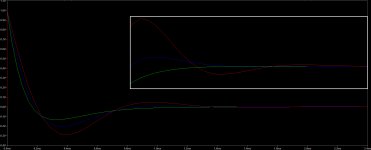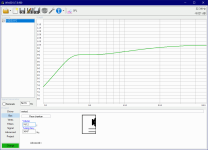Both arguments are totally useless without knowing ANY context, goals and constraints.Some might argue that Bessel response [Q = 1/sqrt(3) -- maximally-flat delay] is superior. Depends upon circumstances.
There is NO perfect.
Bessel response [Q = 1/sqrt(3)
With a sealed box it is my typical target. 0.58 rounded off. Also a good starting point for an optimal miniOnken vented alignment.
dave
Dave, I am trying to resist the temptation of building these miniOnken guys, but you are not helping. I may give in after all.
Unfortunately, Bessel highpass filters do not share the excellent transient response of Bessel lowpass filters. They're still good, though.With a sealed box it is my typical target. 0.58 rounded off.
And which of the following step responses is "transient perfect"?Yeah, though I grew up with critically damped = max flat/0.707; 0.5 = transient perfect.
The plots show the step responses of second-order high-pass filters with values of Q = 0.7071, 0.5, and 1.0. Note that each of the high-pass response functions have the same a –3dB point: 50Hz. In this comparison, the Q = 0.7071 response has the shortest settling time, but it has the second-largest oevershoot in the negative direction, but not by a very great amount.
So what’s a ‘critically damped’ box for this? Probably one of the lowest Qts in all of subwooferland.
https://www.parts-express.com/pedocs/specs/294-6028--bc-18ds115-4-spec-sheet.pdf
https://www.parts-express.com/pedocs/specs/294-6028--bc-18ds115-4-spec-sheet.pdf
According to WinISD, 28.2 liters will give Qtc = 0.500. That's really tiny for an 18" woofer.
Expected for such low Qts. What is F6/F10?
dave
WinISD recommends vented Extended Bass Shelf 6 alignment that drops 3 dB below the shelf at around 32 Hz.
With 1700W power handling capability, you could EQ the snot out of it, if you don't mind it doubling as a space heater.
Yeah, that’s not useful unfortunately . can you even dsp it into More neutered bass? Edit: you said ‘space heater already ’. 😝👍🏼According to WinISD, 28.2 liters will give Qtc = 0.500. That's really tiny for an 18" woofer.
Last edited:
A 10' tapped pipe only gains a couple of dB and a few Hz over a 74 liter vented box, below about 50 Hz.Best I could do was a 300cm long tapped pipe
Attachments
None actually since there can't be anything below the line according to both a local Altec engineer and an old local curmudgeonly E.E. that worked at W.E. in the early days of cinema sound circa '66 that noted the best we can do 'perfect' in sound reproduction was a 'euphonically' distorted response, which IME 0.5 is my 'perfect' transient response based more on the much better hearing of young females than my then youthful hearing already damaged from game hunting, auto racing and several other hearing damaging hobbies/endeavors.And which of the following step responses is "transient perfect"?
- Home
- Loudspeakers
- Subwoofers
- I hate math

